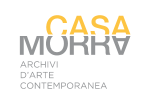Casa Morra
4° anno – 2022 – Gli Unici – JEAN TOCHE
Jean Toche (1932-2018) è irriducibile, incandescente, dagli anni Sessanta in poi, tra Bruxelles, Parigi e New York. Rivoluzionario e solitario, si è incrociato con gli Art Workers Coalition (AWC) e gli AHA-NY che hanno lottato, negli anni Sessanta, contro la guerra in Vietnam, per il riconoscimento dei diritti degli artisti. Toche era amico di Marcel Broodthaers con il quale, a Parigi, passava serate fumose a discutere dell’arte, del capitale e del potere. È stato un guerrigliero, ha usato corpo e mente come arma e scudo contro le ingiustizie. Ha lottato per difendere le minoranze e gli oppressi, prima con la performance, poi con l’autoscatto e la mail-art. Ha ripetutamente rischiato la vita per essersi messo contro il KKK a Staten Island dove è andato ad abitare dagli anni Settanta. Il 15 ottobre 1969, a New York – con Jon Hendricks e Poppy Johnson – fonda il Guerrilla Art Action Group (GAAG). Alle azioni di disturbo, che si svolgono tra il 1969 e il 1971, partecipano anche la moglie Virginia Poe e Joanne Stamerra. In questo periodo, Toche viene perseguitato ripetutamente e violentemente e ciò rafforza la sua integrità e la sua volontaria sottrazione al sistema dell’arte. Quando il gruppo si scioglie, nel 1976, dopo incursioni guerrigliere nei musei, Toche si ritira dalla produzione artistico-performativa. Con l’11 settembre 2001 però riprende la propria guerra virtuale. Dallo scioglimento del GAAG e dopo ripetuti arresti, all’artista viene interdetto l’ingresso a tutti i musei americani come si trattasse di un pericoloso criminale. Negli ultimi anni, Toche userà l’autoscatto associando la propria immagine di uomo solo a caustiche e lucide considerazioni politiche sulle malefatte dell’impero americano. I testi, che analizzano ossessivamente tutti gli articoli del New York Times, costituiscono un prezioso diario per i posteri che leggeranno, dei primi anni Duemila, una storia completamente nuova.
Manuela Gandini
—
Jean Toche (1932-2018) was irreducible, incandescent; he worked between Brussels, Paris, and New York from the 1960s. A revolutionary and a loner, he crossed paths with the Art Workers Coalition (AWC) and the AHA-NY, struggling for the recognition of artists’ rights and rallying against the war in Vietnam in the 1960s. Toche was a friend of Marcel Broodthaers, with whom he spent evenings in Paris smoking and discussing art, capital, and power. He was a guerrilla, using his body and mind as a weapon and a shield against injustice. He fought for minorities and the oppressed, initially through performance, then with photographic self-portraits and mail-art. He repeatedly risked his life standing up against the KKK on Staten Island, where he lived from the 1970s. On 15 October 1969 – with Jon Hendricks and Poppy Johnson – he founded the Guerrilla Art Action Group (GAAG) in New York. His wife Virginia Poe and Joanne Stamerra also took part in disruptive actions between 1969 and 1971. Toche was repeatedly and violently persecuted at the time, which reinforced his integrity and his voluntary withdrawal from the art system. When the group broke up in 1976, after guerrilla raids on art galleries, Toche abandoned performance art. After 11 September 2001, however, he resumed his virtual warfare. With the dissolution of GAAG, and after repeated arrests, he was banned from entering any American museum, as if he were a dangerous criminal. In his later years, Toche used the self-timer to associate his image as a lonely man with caustic and lucid political ideas about the misdeeds of the American Empire. His writings, which obsessively analyse all the articles in the New York Times, constitute a precious diary for posterity and will provide insight into an entirely new history of the early 2000s.
Manuela Gandini
